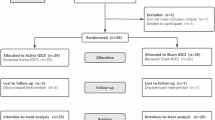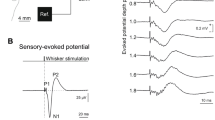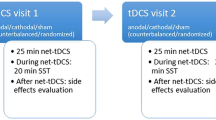Abstract
Arousal and sleep are fundamental physiological processes, and their modulation is of high clinical significance. This study tested the hypothesis that total sleep time (TST) in humans can be modulated by the non-invasive brain stimulation technique transcranial direct current stimulation (tDCS) targeting a ‘top-down’ cortico-thalamic pathway of sleep-wake regulation. Nineteen healthy participants underwent a within-subject, repeated-measures protocol across five nights in the sleep laboratory with polysomnographic monitoring (adaptation, baseline, three experimental nights). tDCS was delivered via bi-frontal target electrodes and bi-parietal return electrodes before sleep (anodal ‘activation’, cathodal ‘deactivation’, and sham stimulation). Bi-frontal anodal stimulation significantly decreased TST, compared with cathodal and sham stimulation. This effect was location specific. Bi-frontal cathodal stimulation did not significantly increase TST, potentially due to ceiling effects in good sleepers. Exploratory resting-state EEG analyses before and after the tDCS protocols were consistent with the notion of increased cortical arousal after anodal stimulation and decreased cortical arousal after cathodal stimulation. The study provides proof-of-concept that TST can be decreased by non-invasive bi-frontal anodal tDCS in healthy humans. Further elucidating the ‘top-down’ pathway of sleep-wake regulation is expected to increase knowledge on the fundamentals of sleep-wake regulation and to contribute to the development of novel treatments for clinical conditions of disturbed arousal and sleep.
Similar content being viewed by others
Log in or create a free account to read this content
Gain free access to this article, as well as selected content from this journal and more on nature.com
or
References
Berridge CW, Schmeichel BE, España RA (2012). Noradrenergic modulation of wakefulness/arousal. Sleep Med Rev 16: 187–197.
Borbély AA (1982). A two process model of sleep regulation. Hum Neurobiol 1: 195–204.
Borbély AA (2009). Refining sleep homeostasis in the two-process model. J Sleep Res 18: 1–2.
Cardin JA, Carlén M, Meletis K, Knoblich U, Zhang F, Deisseroth K et al (2009). Driving fast-spiking cells induces gamma rhythm and controls sensory responses. Nature 459: 663–667.
Carney CE, Buysse DJ, Ancoli-Israel S, Edinger JD, Krystal AD, Lichstein KL et al (2012). The consensus sleep diary: standardizing prospective sleep self-monitoring. Sleep 35: 287–302.
Cartwright RD, Weiss M (1975). The effects of electrosleep on insomnia revisited. J Nerv Ment Dis 161: 134–137.
Chauvette S, Volgushev M, Timofeev I (2010). Origin of active states in local neocortical networks during slow sleep oscillation. Cereb Cortex 20: 2660–2674.
Clayton MS, Yeung N, Cohen Kadosh R (2015). The roles of cortical oscillations in sustained attention. Trends Cogn Sci 19: 188–195.
Coursey RD, Frankel BL, Gaarder KR, Mott DE (1980). A comparison of relaxation techniques with electrosleep therapy for chronic, sleep-onset insomnia a sleep-EEG study. Biofeedback Self Regul 5: 57–73.
Duchenne de Boulogne GBA (1876) Mécanisme de la Physionomie Humaine ou Analyse Électro-Physiologique de l'Expression des Passions. 2nd edn. Librairie J.-B. Bailliere et Fils: Paris.
España RA, Scammell TE (2011). Sleep neurobiology from a clinical perspective. Sleep 34: 845–858.
Feighner JP, Brown SL, Olivier JE (1973). Electrosleep therapy: a controlled double blind study. J Nerv Ment Dis 157: 121–128.
Finger S, Piccolino M (2011) The Shocking History of Electric Fishes. Oxford University Press: New York.
Frankel BL, Buchbinder R, Snyder F (1973). Ineffectiveness of electrosleep in chronic primary insomnia. Arch Gen Psychiatry 29: 563–568.
Frase L, Maier JG, Zittel S, Freyer T, Riemann D, Normann C et al (2015). Bifrontal anodal transcranial direct current stimulation (tDCS) improves daytime vigilance and sleepiness in a patient with organic hypersomnia following reanimation. Brain Stimul 8: 844–846.
Gandiga PC, Hummel FC, Cohen LG (2006). Transcranial DC stimulation (tDCS): a tool for double-blind sham-controlled clinical studies in brain stimulation. Clin Neurophysiol 117: 845–850.
Grossheinrich N, Rau A, Pogarell O, Hennig-Fast K, Reinl M, Karch S et al (2009). Theta burst stimulation of the prefrontal cortex: safety and impact on cognition, mood, and resting electroencephalogram. Biol Psychiatry 65: 778–784.
Hearst ED, Cloninger CR, Crews EL, Cadoret RJ (1974). Electrosleep therapy—a double-blind trial. Arch Gen Psychiatry 30: 463–466.
Holz J, Piosczyk H, Feige B, Spiegelhalder K, Baglioni C, Riemann D et al (2012). EEG Σ and slow-wave activity during NREM sleep correlate with overnight declarative and procedural memory consolidation. J Sleep Res 21: 612–619.
Iber C (2007) The AASM Manual for the Scoring of Sleep and Associated Events: Rules, Terminology and Technical Specifications. American Academy of Sleep Medicine: Westchester, IL.
Insel TR (2014). The NIMH Research Domain Criteria (RDoC) Project: precision medicine for psychiatry. Am J Psychiatry 171: 395–397.
Jacobson L, Koslowsky M, Lavidor M (2012). tDCS polarity effects in motor and cognitive domains: a meta-analytical review. Exp Brain Res 216: 1–10.
Kuo M, Paulus W, Nitsche MA (2014). Therapeutic effects of non-invasive brain stimulation with direct currents (tDCS) in neuropsychiatric diseases. Neuroimage 85 (Pt 3): 948–960.
Le Bon-Jego M, Yuste R (2007). Persistently active, pacemaker-like neurons in neocortex. Front Neurosci 1: 123–129.
Marshall L, Helgadóttir H, Mölle M, Born J (2006). Boosting slow oscillations during sleep potentiates memory. Nature 444: 610–613.
Marzano C, Moroni F, Gorgoni M, Nobili L, Ferrara M, de Gennaro L (2013). How we fall asleep: Regional and temporal differences in electroencephalographic synchronization at sleep onset. Sleep Med 14: 1112–1122.
Medeiros LF, de Souza IC, Vidor LP, de Souza A, Deitos A, Volz MS et al (2012). Neurobiological effects of transcranial direct current stimulation: a review. Front Psychiatry 3: 110.
Monte-Silva K, Kuo M, Hessenthaler S, Fresnoza S, Liebetanz D, Paulus W et al (2013). Induction of late LTP-like plasticity in the human motor cortex by repeated non-invasive brain stimulation. Brain Stimul 6: 424–432.
Monte-Silva K, Kuo M, Liebetanz D, Paulus W, Nitsche MA (2010). Shaping the optimal repetition interval for cathodal transcranial direct current stimulation (tDCS). J Neurophysiol 103: 1735–1740.
Moruzzi G, Magoun HW (1949). Brain stem reticular formation and activation of the EEG. Electroencephalogr Clin Neurophysiol 1: 455–473.
Nelson LE, Guo TZ, Lu J, Saper CB, Franks NP, Maze M (2002). The sedative component of anesthesia is mediated by GABA(A) receptors in an endogenous sleep pathway. Nat Neurosci 5: 979–984.
Nissen C, Feige B, König A, Voderholzer U, Berger M, Riemann D (2001). Delta sleep ratio as a predictor of sleep deprivation response in major depression. J Psychiatr Res 35: 155–163.
Nissen C, Kloepfer C, Feige B, Piosczyk H, Spiegelhalder K, Voderholzer U et al (2011). Sleep-related memory consolidation in primary insomnia. J Sleep Res 20: 129–136.
Nitsche MA, Cohen LG, Wassermann EM, Priori A, Lang N, Antal A et al (2008). Transcranial direct current stimulation: state of the art 2008. Brain Stimul 1: 206–223.
Nitsche MA, Doemkes S, Karaköse T, Antal A, Liebetanz D, Lang N et al (2007). Shaping the effects of transcranial direct current stimulation of the human motor cortex. J Neurophysiol 97: 3109–3117.
Nitsche MA, Jakoubkova M, Thirugnanasambandam N, Schmalfuss L, Hullemann S, Sonka K et al (2010). Contribution of the premotor cortex to consolidation of motor sequence learning in humans during sleep. J Neurophysiol 104: 2603–2614.
Nitsche MA, Liebetanz D, Lang N, Antal A, Tergau F, Paulus W (2003). Safety criteria for transcranial direct current stimulation (tDCS) in humans. Clin Neurophysiol 114: 2220–2222, author reply 2222-3.
Nitsche MA, Paulus W (2000). Excitability changes induced in the human motor cortex by weak transcranial direct current stimulation. J Physiol (Lond) 527 (Pt 3): 633–639.
Nofzinger EA, Buysse DJ, Germain A, Price JC, Miewald JM, Kupfer DJ (2004). Functional neuroimaging evidence for hyperarousal in insomnia. Am J Psychiatry 161: 2126–2128.
Nofzinger EA, Nissen C, Germain A, Moul D, Hall M, Price JC et al (2006). Regional cerebral metabolic correlates of WASO during NREM sleep in insomnia. J Clin Sleep Med 2: 316–322.
Peterchev AV, Wagner TA, Miranda PC, Nitsche MA, Paulus W, Lisanby SH et al (2012). Fundamentals of transcranial electric and magnetic stimulation dose: definition, selection, and reporting practices. Brain Stimul 5: 435–453.
Polanía R, Paulus W, Nitsche MA (2012). Modulating cortico-striatal and thalamo-cortical functional connectivity with transcranial direct current stimulation. Hum Brain Mapp 33: 2499–2508.
Ranieri F, Podda MV, Riccardi E, Frisullo G, Dileone M, Profice P et al (2012). Modulation of LTP at rat hippocampal CA3-CA1 synapses by direct current stimulation. J Neurophysiol 107: 1868–1880.
Riedner BA, Vyazovskiy VV, Huber R, Massimini M, Esser S, Murphy M et al (2007). Sleep homeostasis and cortical synchronization: III. A high-density EEG study of sleep slow waves in humans. Sleep 30: 1643–1657.
Riemann D, Nissen C . Sleep and Psychotropic Drugs. In: Morin CM, Espie CA (eds). Oxford Handbook of Sleep and Sleep Disorders. Oxford University Press: Oxford; (2012), pp 190–222.
Riemann D, Nissen C, Palagini L, Otte A, Perlis ML, Spiegelhalder K (2015). The neurobiology, investigation, and treatment of chronic insomnia. Lancet Neurol 14: 547–558.
Riemann D, Spiegelhalder K, Feige B, Voderholzer U, Berger M, Perlis M et al (2010). The hyperarousal model of insomnia: a review of the concept and its evidence. Sleep Med Rev 14: 19–31.
Robins LN, Wing J, Wittchen HU, Helzer JE, Babor TF, Burke J et al (1988). The Composite International Diagnostic Interview. An epidemiologic Instrument suitable for use in conjunction with different diagnostic systems and in different cultures. Arch Gen Psychiatry 45: 1069–1077.
Saper CB, Scammell TE, Lu J (2005). Hypothalamic regulation of sleep and circadian rhythms. Nature 437: 1257–1263.
Sconocchia S (ed) (1983) Sribonii Largi Compositiones. B. G. Teubner: Leipzig.
Steriade M (1995). Neuromodulatory systems of thalamus and neocortex. Sem Neurosci 7: 361–370.
Steriade M (2006). Grouping of brain rhythms in corticothalamic systems. Neuroscience 137: 1087–1106.
Steriade M, Nuñez A, Amzica F (1993). A novel slow (1 Hz) oscillation of neocortical neurons in vivo: depolarizing and hyperpolarizing components. J Neurosci 13: 3252–3265.
von Richthofen CL, Mellor CS (1979). Cerebral electrotherapy: Methodological problems in assessing its therapeutic effectiveness. Psychol Bull 86: 1264–1271.
Voss U, Holzmann R, Hobson A, Paulus W, Koppehele-Gossel J, Klimke A et al (2014). Induction of self awareness in dreams through frontal low current stimulation of gamma activity. Nat Neurosci 17: 810–812.
Wang X (2010). Neurophysiological and computational principles of cortical rhythms in cognition. Physiol Rev 90: 1195–1268.
Zimmermann P, Fimm B (2007) Testbatterie zur Aufmerksamkeitsleistung (TAP). Psytest: Würselen, Germany.
Acknowledgements
This work has been supported by intramural funds of the University Medical Center Freiburg. MK and JGM have received PhD grants provided by the FAZIT foundation. MAN receives research support within the framework of the EU Research and Innovation programme Horizon 2020 (grant 686764, LUMINOUS).
Author information
Authors and Affiliations
Corresponding author
Additional information
Supplementary Information accompanies the paper on the Neuropsychopharmacology website
Rights and permissions
About this article
Cite this article
Frase, L., Piosczyk, H., Zittel, S. et al. Modulation of Total Sleep Time by Transcranial Direct Current Stimulation (tDCS). Neuropsychopharmacol 41, 2577–2586 (2016). https://doi.org/10.1038/npp.2016.65
Received:
Revised:
Accepted:
Published:
Issue date:
DOI: https://doi.org/10.1038/npp.2016.65
This article is cited by
-
Transcranial random noise stimulation combined with cognitive training for treating ADHD: a randomized, sham-controlled clinical trial
Translational Psychiatry (2023)
-
Sleep patterns correlates with the efficacy of tDCS on post-stroke patients with prolonged disorders of consciousness
Journal of Translational Medicine (2022)
-
Impact of transdermal trigeminal electrical neuromodulation on subjective and objective sleep parameters in patients with insomnia: a pilot study
Sleep and Breathing (2022)
-
Transcranial direct current stimulation induces long-term potentiation-like plasticity in the human visual cortex
Translational Psychiatry (2021)
-
Sleep, insomnia, and depression
Neuropsychopharmacology (2020)



